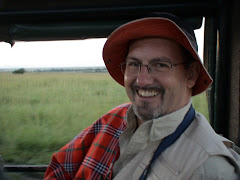This was the headline of one of the stories I read in yesterday's issue of The Daily Nation, one of Kenya's main newspapers. Although the story is still about allegations, rather than determined facts, I cannot help but believe that there is quite a bit of truth to it. Here are some excerpts from the entire story:
A Kenyan has sued his former college and it athletics coach for allegedly forcing him to drink blood four years ago.
Mr. Charles Ngetich filed suit against Central Connecticut State University and retired track coach Mr. George Kawecki last Thursday alleging he was subjected to three years of racism.
Mr. Ngetich was allegedly forced to drink blood before being kicked out of the athletics team. He lost his scholarship and was dismissed on September 4, 2009.
The lawyer, Ms. Josephine Miller, says in 2005 the coach told Mr. Ngetich he would like to see him drink blood.
Mr. Ngetich thought he was joking and declined but two weeks later, Mr. Kawecki approached him again, saying he had seen a documentary about a Kenyan group that drinks blood for rituals.
"At a track team meeting... Kawecki produced a cup of blood, told (Ngetich) he was too thin, needed calcium and demanded that he drinks it."
Why do people (allegedly) act in such a way? People who are in positions of power abuse their position and cause pain to others. Why do people act in such a racist and despicable manner? Why do I have to speak out against the actions of some of my fellow Americans? When will we learn that our actions perpetuate the feelings of dislike against us as a country?
I'd prefer not to write about this at all, but I have been involved in a couple of Facebook discussion threads on speaking out against others who are racially motivated. I've stated that one has to speak out or he/she is condoning the action. Those threads were about the vitriolic state of the health care debate, but the principal carries over into this specific story as well.
I cannot purport to know what documentary Coach Kawecki saw, but I have to assume that it might have been one on the Maasai tribe. There are around 40 separate indigenous tribes in Africa and the Maasai are one of the smaller ones in terms of numbers. However, they are probably one of the most well recognized ones due to their proximity to the Masai Mara wildlife and adherence to traditional practices and wardrobe.
So, is it a ritual to drink blood? I wouldn't call it a ritual so much as simply common practice. The Maasai people are herders and pastoralists. They herd cows and goats and that is the measure of their wealth. They do not grow crops. Because they do not have crops, their diet is "peculiar" when compared to what we eat in the United States. They rely almost entirely on either meat, dairy or some combination thereof. Eating meat on a daily basis would mean diminishing their wealth through the killing of animals. Thus, they rely on milk and blood. They will "bleed" an animal and drink the blood as a way to get nourishment. It's simply the way it is.
It is sadly ironic that Ngetich was forced (again, allegedly) to do something that is closely associated with the Maasai. I did a quick Google search to find out what tribe is associated with the name "Ngetich." It came back as part of the Kipsigis tribe, which is a sub-tribe of the Kalenjins. The Kipsigis live mainly in the Kericho District which borders the Maasai lands. I say, sadly ironic, because there was a lot of post-election violence in this area in January, 2008.
Wesley Ngetich, a well known Kenyan marathon runner, was killed in January 2008 during clashes with some people of the Maasai tribe. The post-election violence is a matter that is still being dragged out without resolution. However, the idea that an American coach would assume that ALL Kenyans partake in the same tribal practices shows his ignorance about Kenyan cultures.
I'd like to apologize to Charles for the actions of my fellow countryman. I hope that he understands that not everyone in the United States condones the actions of the few. I hope he is able to continue his university studies. I hope that he can come away from this with more good memories than bad memories.





